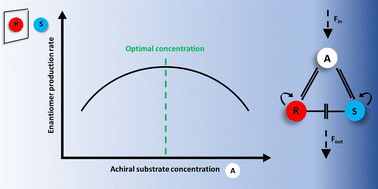Spontaneous mirror symmetry breaking in reaction–diffusion systems: ambivalent role of the achiral precursor†
Abstract
The behaviour of a Frank-like chemical network model featuring autocatalytic production of chiral enantiomers from achiral reactants is studied numerically in 1D and 2D systems using fluctuating initial conditions and accounting for diffusion processes. Our results reveal that the achiral substrate concentration can play an ambivalent role. It is shown that when the achiral reactant concentration is maintained constant and homogeneous in 1D systems, global homochirality is not systematically reached when the size of the system or the achiral reactant concentration are increased. However, with a fixed concentration gradient, coexisting homochiral domains of opposite handedness are no longer observed and homogeneous homochirality, i.e. the presence of a single stable homochiral domain, is recovered. In 2D systems, reaching global homochirality is just a matter of time. This time is dramatically increased when insufficient or excessive amount of achiral reactant is used. An optimal amount of achiral material is observed to maximise the enantiomer production rates.



 Please wait while we load your content...
Please wait while we load your content...